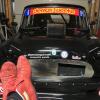
Valve Clearances - Understanding Tolerances
#1

Posted 22 November 2015 - 04:21 PM
Haynes says 0.3mm for valve clearances, when the opposite valve is fully open.
So, into 4th gear, roll the car forwards to get the rocker at its lowest and measure the gap on the corresponding closed valve.
Q1: Since I don't have a dial guage, I'm having to get the rockers to there extreme positions by eye. How critical is it to have a valve EXACTLY fully open to get max clearance on the corresponding closed valve?
Q2: With the plugs it seemed easy to judge +/-0.05mm. With the tappets it seems much harder. I reckon I could turn the adjuster screw by 10-20deg and still get the dealer guage in with subtle differences in drag on the feeler guage. What sort of difference does this give in clearance and how critical is it?
#2

Posted 22 November 2015 - 04:53 PM
Don't take my word for it, but me and my brother were talking about this as we were doing my valve clearances.
If you think about the shape of the cam there is a large period of time when the pushrod is not being forced up. So it was our thinking that along as your as close as you can get by eye you should be well within the duration of the cam where the valve is closed.
I might be proved wrong in which case i might be redoing my clearances when someone explains the best way to get it exactly open.
I think q2 is much more to do with having a good feel for it. we ere setting the clearances so you could feel a slight drag on the feeler gauge when trying to remove it, tightening the nut off and then trying to rock the rocker to feel for any movement with the gauge still in. If you could feel any movement at all we reset the clearance.
#3

Posted 22 November 2015 - 05:18 PM
Not quite what is says. But close.Haynes says 0.3mm for valve clearances, when the opposite valve is fully open.
As you are setting the clearance on the round bottom profile of the cam you only need to be at about the right area.
#4

Posted 22 November 2015 - 05:26 PM
"The opposite valve". What does that mean?
You must understand that -depending on what cam you have in your engine- that there is always some 'overlap' between the opening times of the inlet valve and the exhaust valve. Meaning, that the exhaust valve is still (a bit) open while closing when the inlet valve was opening already. By this way the vanishing exhaust gasses 'suck' the burning room empty. And -when the inlet valve is open jet- sucks on the inlet manifold. So, while the piston almost stands still in the cilinder -while being in the top death centre- already fresh gas is coming into the burning room.
There for it is better to control the valve clearance of both valves of the cilinder that just had its compression stroke and is about to deliver the working stroke whilst the piston goes down.
The crank is 180 degens, so piston 1 and 4 are at TDC the same time and 180 degens later are pistons 2 and 3.
The firing order of the engine is 1342.
So, just before cilinder number one is sparking cilinder number four is in his exhaust stroke and about to inhale the next fresh flow of gas to burn. You can see that when you have taken off the rocker box and look at the rockers whilst pushing forward the car by hand and in the fourth gear. The rocker of the exhaust valve of cilinder four pushed down the exhaust valve and is coming up jet, whilst the rocker of the inlet valve gets moving to push the inlet valve down. The rockers are 'on the rock'.
So, when the rockers of cilinder four are moving, you are sure that the valves of cilinder 1 are dead shut. And you can use your feeler gauge to see if the clearance is right.
Are the rockers of cilinder four 'on the rock' you can control the clearance of cilinder one. Are the rockers of cilinder two on the rock, control the cilinder three. Are the rockers of cilinder three on the rock, you can see at the clearance of cilinder two.
Am I right?
Edited by Wim Fournier, 22 November 2015 - 06:08 PM.
#5

Posted 22 November 2015 - 05:37 PM
You could devide the engine in the middle, then the valve you set the gap to is the mirrored opposite , see this as a graph with the Y axis going through the centre of the Block, valves numbered from -4 to 4 op the X axis.
#6

Posted 22 November 2015 - 05:39 PM
Will - the opposite valve is a mirror 'image' if you put an imaginary line between cylinders 2 & 3.
So, if No. 8 Valve is open, set No. 1, however with 8 ports heads, this sequence is different.
A1. As Mood 1990 has said, it's not at all critical, just Open, that puts the 'opposite' valve's cam follow on the base circle of the cam.
A2. Not easily described with words, but as long as there is a 'feelable' drag on the feeler gauge (and with tappets, less is safer than more drag).
Remember too, that any 'measurement' by using a Feel Gauge is not a true measurement in real meaning of 'measurement', it is a comparison of what it is you are measuring to the gauge. Using say a Dial Gauge you can actually 'measure'. Nothing wrong with feeler gauges but it's handy to understand what it is and it's 'limitations'.
#7

Posted 22 November 2015 - 06:19 PM
It's also good practice to swipe the feeler gauge from side to side rather than in and out.
#8

Posted 22 November 2015 - 07:13 PM
That's what I thiught about fully open vs closed, but good to have it confirmed.
How would you use a dial guage to set the clearances? I can't think how you'd ascertain a datum.
#9

Posted 22 November 2015 - 09:32 PM
I would never and have never used a DTI to set the valve clearances. A set of feeler gauges and the use of the 'rule of nine' is the way to do it.
With standard rockers if you set 0.012" at cold for inlets & exhausts, whilst with a 1.5:1 ratio rocker shaft you can set 0.015" at cold. In fact, with a 1.5:1 shaft it is quite OK to set 0.012" for the inlets at cold as the inlet calves done get hot and expand as the exhaust valves do.
1 user(s) are reading this topic
0 members, 1 guests, 0 anonymous users


















